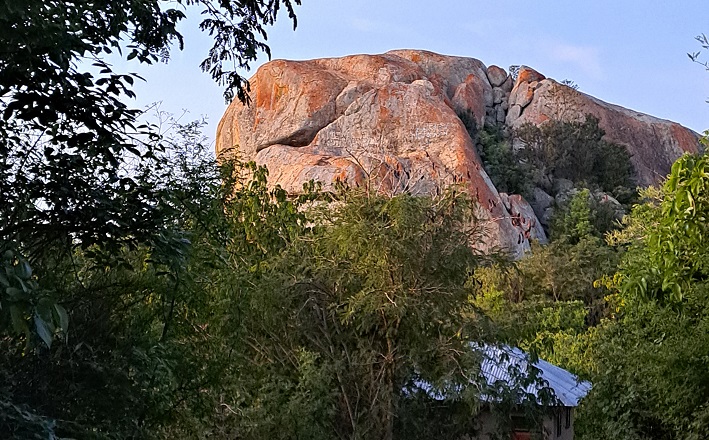There are lots of mountains in the Gospel of Matthew. Jesus is tempted by Satan on one mountain (Matthew 4:8); he teaches from another, which is why we call that particular discourse “the Sermon on the Mount” (Matthew 5:1). He heals and feeds the crowds on a mountain (Matthew 15:29), and of course, he talks with Moses and Elijah on the Mount of Transfiguration, which is the story we hear this week (Matthew 17).
Living in the relatively flat terrain of Minnesota, I do not get to see mountains very often. So I was delighted last month when I had the good fortune of seeing the mountains and highlands of the Iringa region of central Tanzania. I was leading a group of Luther Seminary students on a study course designed to immerse them in the life of the church of the Global South.
In this case, the churches that we visited were those of the Evangelical Lutheran Church in Tanzania (ELCT). The ELCT is a rapidly growing, vibrant church body comprised of some 8 million members. It is one of the largest Lutheran church bodies in the world and it is part of the remarkable growth of Christianity in the Global South, where more than two-thirds of the world’s Christians now live.1
Our group had the opportunity to meet and study with several ELCT pastors over the course of a couple of weeks. We heard about how they provide pastoral care, how they structure their parishes, how they do evangelism and discipleship training. We toured a university, a hospital, an orphanage, and primary and secondary schools, all founded and run by the churches of the Iringa Diocese of the ELCT.
The dedication and the hard work that this all requires cannot be overstated. But these pastors and church leaders did not exude weariness or solemnity. They all take the Gospel and the Great Commission very seriously, but they do not take themselves too seriously. They love to laugh (often at themselves) and they love to sing.
One particularly memorable evening found us scrambling up something akin to a mountain, though in this case, it was more of a giant granite boulder. Gangilonga Rock looms a couple of hundred feet over the city of Iringa and is a marvelous place from which to watch the sunset. On the top of the enormous rock, which is relatively flat, we took photos and admired the view. And then the Tanzanian pastors started to sing. And they danced, forming a circle as each took a turn in the middle, moving in time to the music. They encouraged us to join them and we did the best we could, much to their amusement (I have some gifts, but dancing is not one of them).
One of the songs was particularly moving. The title (in Swahili) is “Bwana U Sehemu Yangu” (Lord, you are my portion). It is a call-and-response song and speaks of walking with the Lord even in the midst of suffering: “Lord, you are my portion / More than a friend to me / Together with You/ In my pilgrim journey / let me walk with You.”2
Now, it must be said that these pastors and the members of their churches have more than their share of challenges. As in many African nations, the shadow of colonialism still affects daily life in Tanzania. And as in many African nations, corruption is rampant in the government, which means that basic services like education and health care are sorely underfunded and inadequate. (One primary school teacher we met had 100 students in her classroom.) The parishes are not able to pay their pastors adequate salaries, so the pastors often have another job or they farm part-time to supplement their families’ income.
In other words, these pastors we met had plenty of experience with times of suffering, but they also had something else—confidence that God walks with them in those times of suffering, and therefore a kind of lightness, a kind of joy in the Lord that they shared with us, their brothers and sisters in Christ, especially on that memorable evening on Gangilonga Rock as the sun set over the mountains.
+ + +
It is sometimes difficult to find that kind of joy expressed in the North American church, or at least in the mainline Protestant church. We are surrounded by narratives of decline and we see evidence of it in many of our own parishes, where the pandemic has only accelerated a trend towards people disaffiliating from local congregations.
One of the books I assigned the students in the travel course was Lamin Sanneh’s Whose Religion is Christianity? The Gospel Beyond the West. Sanneh, originally from Gambia, was a professor at Yale University and wrote several books on the rise of Christianity in Africa. He wrote in this 2003 book about the decline of Christianity in Europe, but I daresay his words ring true for much of the mainline North American church today:
About the decline, the statistics are unequivocal. But beneath and beyond that has been a strategic retreat into isolation where the spirit seems to be wilting. It has taken the form of a mood swing in which people have been preoccupied with taking stock, with the setting sun and lengthening shadows, with memorial armbands, with shades of gray, with requiem … The religious imagination seems to have been hit with a bout of melancholy as it labors with strains of “Abide with me, fast falls the eventide” and “The Day Thou gavest, Lord, is ended, / The darkness falls at Thy behest.” It’s the solemn vespers without the Gloria, and it is a far cry from the confident, robust tones of “Onward, Christian Soldiers” or “Stand up, stand up for Jesus!” … It’s as if Europeans have the Nunc Dimittis constantly on their lips, and so regret having to celebrate Christmas or Easter. Maybe too much history is a bad thing.3
Does this description ring true for you, Working Preachers? I hope not, but I’m guessing that it does for some of you, at least on the hard days. Many of my students described a similar kind of feeling as they prepare for ministry. But they also remarked on the joy that they had experienced in the Tanzanian church and they spoke of how they might bring that joy into their own ministries. One student said, “Because of this trip, I have hope for the church for the first time in my adult life.”
+ + +
Now Gangilonga Rock is not the Mount of Transfiguration. There was no vision or heavenly voice. But there was singing and dancing and a kind of joy that we in the mainline Western church sometimes forget in the midst of hard times and cultural conflict. I am reminded of a Roman Catholic nun I met years ago who, though she worked with down-and-out folks in impoverished neighborhoods, had that same kind of levity about her. “We are people of the resurrection,” she said, “We have every reason to be joyful!”
We do have every reason to be joyful, because the church is growing, the Gospel is being shared. Communities of hope (as Sanneh calls them) are being established all over the world.4 And we get to be a part of that, rooted in the commission and the promise that Jesus gave to his disciples (including us) on yet another mountain at the end of Matthew: “Go and make disciples of all nations … And remember, I am with you always, to the very end of the age” (Matthew 28:20).
Wishing you joy in your journey,
Kathryn
Notes
- This growth is in large part the topic of the book, From Times Square to Timbuktu: The Post-Christian West Meets the Non-Western Church by Wesley Granberg-Michaelson (Eerdmans, 2013). To cite just one statistic, there are now more Protestants in Nigeria than in Germany, the birthplace of the Reformation.
- For one version of the song, with English translation, see this video: https://www.youtube.com/watch?v=MBOV_ftgCNA. For a more energetic (though briefer) version, with dancing, see this one: https://www.youtube.com/watch?v=vLF9-IM8Ljs
- Lamin Sanneh, Whose Religion is Christianity? The Gospel Beyond the West (Eerdmans, 2003), 30.
- Sanneh, 32.

